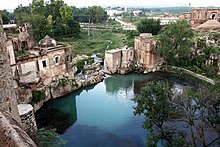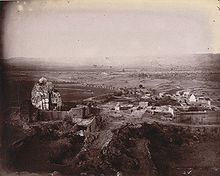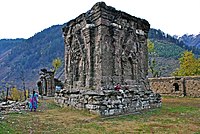Katas Raj Temples: Difference between revisions
added Category:Ruins in Pakistan using HotCat |
m →Legends: spelling grammar a bit of legend even |
||
| Line 75: | Line 75: | ||
==Legends== |
==Legends== |
||
Katasraj temple complex is believed to date back to the Mahabharata era. Many legends are associated with the temples. |
The Katasraj temple complex is believed to date back to the Mahabharata era. Many legends are associated with the temples. The five Pandava brothers, heroes of the [[Sanskrit]] epic the [[Mahabharata]], stayed here for four of the 14 years they spent in exile. The lake in the complex is believed to have magical powers and is supposed to be where [[Yudhisthira]] defeated the [[Yaksha]] with his wisdom, bringing his brothers back to life. |
||
Another legend involves the death of Shiva's wife [[Sati (goddess)|Sati]]; the story goes that when she died he cried so much and for so long that his tears created two holy ponds - one at Pushkara in Ajmer and the other at Ketaksha, which literally means "raining eyes" in Sanskrit. It is from this name that the word Ketas is derived. Another version of the legend mentions the two pools at Katasraj and [[Nainital]]. |
Another legend involves the death of Shiva's wife [[Sati (goddess)|Sati]]; the story goes that when she died he cried so much and for so long that his tears created two holy ponds - one at Pushkara in Ajmer and the other at Ketaksha, which literally means "raining eyes" in Sanskrit. It is from this name that the word Ketas is derived. Another version of the legend mentions the two pools at Katasraj and [[Nainital]]. |
||
Yet another version of the Siva legend involves the death of Shiva's horse Katas instead of that of Sati his consort. |
Yet another version of the Siva legend involves the death of Shiva's horse Katas instead of that of Sati his consort. |
||
Some legends also state that very first Shiva Ling (Sihv-Ling) was in Kattas. some old manuscripts also consider Katas as the janam bhoomi (birth place) of ram, as well as, that of Ayudhiya; but this has become quite controversial. |
|||
==Prehistoric tools and weapons== |
==Prehistoric tools and weapons== |
||
Revision as of 06:24, 28 February 2014
| Katasraj temple | |
|---|---|
 View from top of the temple | |
| Religion | |
| Affiliation | Hinduism |
| District | Chakwal district |
| Location | |
| Location | Choa Saidanshah |
| State | Punjab |
| Country | Pakistan |
Katasraj Mandir (Urdu: کٹاس راج مندر, Devanagari: कटास राज मंदिर) is a Hindu mandir or temple complex situated in Katas village near Choa Saidanshah in the Chakwal district of Punjab in Pakistan. Dedicated to Shiva, the temple has existed since the days of Mahābhārata and the Pandava brothers spent a substantial part of their exile at the site. The Pakistan Government is considering nominating the temple complex for World Heritage Site status. In 2007, it also proposed to restore the temple complex.[1] In 2012, the temple pond is drying up due to heavy use of ground water for industrial purposes.[2]
History

The smaller temples, built in pairs around the larger central temple, were built around 900 years or so ago, although the earliest of them dates back to the latter half of the 6th century AD.[3]
The temple complex was not abandoned by Hindus when they migrated to East Punjab in 1947. It has always been the site of holy pilgrimage for people of various faiths. Even nowadays, worshippers of all faiths perform pilgrimage to the mandir. The pilgrims bathe in the sacred pool and seek forgiveness as Hindu belief holds that bathing in the pond (especially on certain occasions) leads to the forgiveness of sins and helps attain salvation. Until recently, it was believed that the pond had unlimited depth.
The two semi-ruined temples of the Hindushahiya period (650–950 AD) have been frequently photographed by newspapers and history journals.
Renovation by the Government of Pakistan
For decades the temple complex was in bad state. The holy pond was littered with garbage, while the murals inside the temples disappeared due to the ravages of time and the neglect of the authorities.
In 2006-07, Pakistan decided to place murtis of Hindu gods in the seven mandirs and restore them to their original state to attract visitors.[1] The budget allocated for the project was Rs. 51.06 million. The temple was visited by India's former deputy prime minister Lal Krishna Advani in 2005.[4] The government decided to import idols of Hindu gods from various monuments in India to Pakistan for the restoration. A three-member archaeological team visited neighbouring India, Sri Lanka and Nepal to collect murtis of Hindu gods.
Location
The Katasraj mandirs are located 40 kilometres from Chakwal District. It takes a little effort to reach Katasraj by road - one has to go off the M2 motorway - (Islamabad - Lahore) at the Kallar Kahar interchange, Then follow the road to Choa Saidan Shah for 24 km and after passing the cement factory the road passes through the temple complex, with the major temple complex and the pond on the right.
Architecture


The Katas site houses the Satgraha, a group of seven ancient temples, remains of a Buddhist stupa, a few medieval temples, havelis and some recently constructed temples, scattered around a pond considered holy by Hindus.[5]The temples at Katas are mostly constructed on square platforms. The elevation of the sub shrines seems to form a series of cornices with small rows of pillars, crowned by a ribbed dome.
The Ramachandra Mandir is situated to the east of the Hari Singh Haveli and is closed from all sides except for an entrance on the east. The double-storied structure has eight rooms of various dimensions on the ground floor and a staircase at the south leading to the first floor. The mandir has two jharokas (balconies) that have been severely damaged.
The Hanuman Mandir is on the western extreme of a high rectangular enclosure with entrances on the south and the north. The temple's ceiling is undecorated, and lime-plastered.
The Shiva temple is also built on a square platform. Its entrance is a recessed round arch with faint cusps and a rectangular opening to the north.
Legends
The Katasraj temple complex is believed to date back to the Mahabharata era. Many legends are associated with the temples. The five Pandava brothers, heroes of the Sanskrit epic the Mahabharata, stayed here for four of the 14 years they spent in exile. The lake in the complex is believed to have magical powers and is supposed to be where Yudhisthira defeated the Yaksha with his wisdom, bringing his brothers back to life.
Another legend involves the death of Shiva's wife Sati; the story goes that when she died he cried so much and for so long that his tears created two holy ponds - one at Pushkara in Ajmer and the other at Ketaksha, which literally means "raining eyes" in Sanskrit. It is from this name that the word Ketas is derived. Another version of the legend mentions the two pools at Katasraj and Nainital.
Yet another version of the Siva legend involves the death of Shiva's horse Katas instead of that of Sati his consort. Some legends also state that very first Shiva Ling (Sihv-Ling) was in Kattas. some old manuscripts also consider Katas as the janam bhoomi (birth place) of ram, as well as, that of Ayudhiya; but this has become quite controversial.
Prehistoric tools and weapons
Prehistoric tools and weapons such as axes and knives made of granite, and artifacts like terracotta bangles and pottery have been unearthed at the Katasraj site. The latter have been found to be similar to those excavated in Harappa, but have not been dated for want of expert opinion. The fascinating Salt Ranges have a vast archaeological treasure still hidden underground. The Salt Ranges have also been yielding prehistoric finds.[6] While some local experts place the fossils discovered in the period between 6000 and 7000 BC, the fact remains that they have not yet been examined by trained palaeontologists of international standing. A large number of bones of the limbs and vertebrae of giant animals resembling the extinct mammoth and dinosaur have been found at some sites. “An entire range of low mountains in the area appears to be fossilized, revealing to the naked eye layer upon layer of a variety of plants and soils,” says one writer.
References
- ^ a b "Pak sends message, fixes temple". 2007-03-25. Retrieved 2007-03-25.
- ^ "Drying up of Katas Raj temple pond has Pak Hindus worried". Rediff News. India. 24 April 2012.
- ^ Old ruined temple at Katas, Jhelum District British Library.
- ^ Playing peacemaker: Advani, Visiting the Katas Raj temple complex near Lahore Frontline, Volume 22 - Issue 13, Jun 18 - Jul 01, 2005.
- ^ "Top Tourist spots in Pakistan". photos: timesofindia.com. 21 May 2012. Retrieved 22 May 2012.
- ^ "A CBM For The Lord". Outlook. India. 27 June 2005.
External links
- Pakistan renovates Katasraj Temples
- Picture tour of Katasraj Temples
- The Temples of Katas Raj in Pictures


